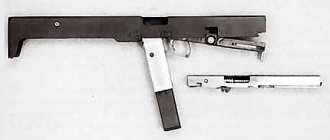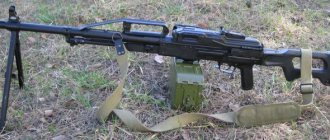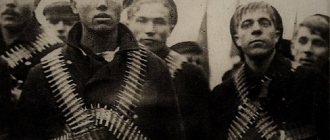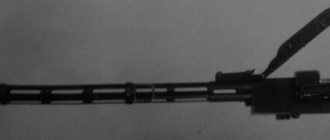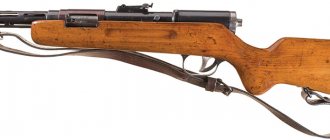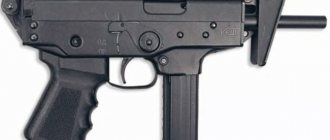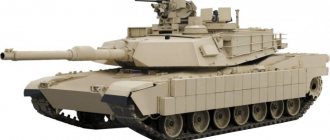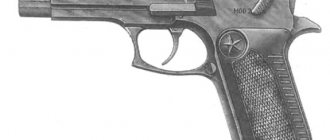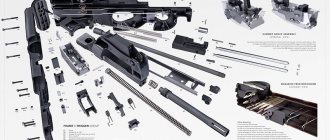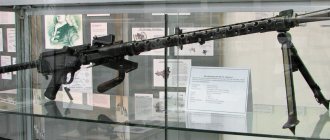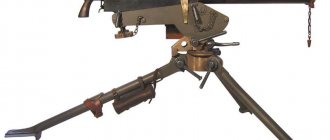Deadly “gramophone”: NI highly appreciated Degtyarev’s machine gun
The National Interest publication told its readers about the Soviet Degtyarev machine gun. Author Peter Suchu notes that despite its archaic appearance, it turned out to be very effective. It is reliable, accurate, and, most importantly, durable.
Like other Soviet small arms, the Degtyarev machine gun could withstand rough handling, be used in the mud and then work like new. Even at low temperatures, he continued to fire at enemy positions when other weapons had already failed.
At first glance at Degtyarev’s machine gun, it is not difficult to guess why he received the nickname “gramophone”. It's all in the large disc-shaped magazine, which holds 47 rounds of 7.62x54 mm ammunition, the same caliber as the Mosin rifle.
The machine gun was designed by Vasily Alekseevich Degtyarev in the late 1920s. He was one of those Soviet designers who created weapons at the end of the tsarist era and continued to work for the new communist regime. Degtyarev even became the head of the very first Soviet firearms design bureau.
During his long career, he created several types of machine guns, machine guns and anti-tank guns. The gunsmith received the rank of Major General of the Engineering and Artillery Service, was a Doctor of Technical Sciences, and then was awarded the title of Hero of Socialist Labor, becoming the second laureate after Joseph Stalin!
One of his first weapons was the DP-28 light machine gun - this is the name by which the Degtyarev machine gun is better known in the West. A top-loading magazine may seem like an odd choice today, but remember that back then many gun manufacturers and designers chose this option. For example, the British Bren Gun and other light machine guns were also top-loaded.
In the case of the DP-28, the round magazine provided plenty of ammunition and also ensured that the line of sight over the weapon was not obstructed. This design also provided mobility that belt-fed light machine guns lacked.
It was heavier than a rifle, but one Red Army soldier could still carry and operate it. The machine gun weighed about 9 kilograms with an empty magazine and 11 with a loaded magazine. That is, it was slightly heavier than the Browning Automatic Rifle and about the same as the Bren Gun. But, unlike these weapons, the soldier needed to be prone or use a bipod to fire accurately.
The DP-28 featured a simple design with very few parts - only 80 in early models. It could fire approximately 550 rounds per minute. This is a lower rate of fire than some machine guns, but it reduces the risk of barrel overheating. Moreover, unlike the German MG34 or the British Bren, the Degtyarev machine gun did not have a replaceable barrel.
One of the main problems of the DP-28 was that the magazine held 47 rounds, and the reloading process was far from fast. As a result, the soldiers had to carry it loaded and carry three more spare magazines.
The Degtyarev machine gun was improved in 1943-44, after which it received the name DPM (Degtyarev Infantry Modernized). This version had a stiffer bipod and an additional pistol grip, making the weapon easier to use.
In total, only about 795,000 DP-28/DPM machine guns were produced by the Soviet Union from 1928 to the early 1950s.
Copies of the weapon were later produced by Poland at the start of the Cold War. China created its own copies of the DPM called the Type 53.
After World War II, the machine gun was used in the Chinese Civil War and even in Vietnam.
Cases of its use have also been recorded in modern conflicts. For example, in Somalia, Libya, Syria and even Afghanistan. This indicates that the “gramophone” continues to work!
Machine guns | Italy
Breda M-1930 light machine gun
The Breda M-1930 machine gun was produced and was a modernized version of the Breda M-1924. It had a quick-change barrel with a fixed magazine. Before feeding cartridges into the chamber, they were lubricated with oil, for which there was a built-in oiler. The magazine was inserted on the right side of the receiver. The weapon had a bipod, a rifle stock and a pistol grip. The machine gun fired only in automatic mode. The machine gun was also used in Portugal. The machine guns captured by the Wehrmacht were used under the designation MG-099(i). In total, about 30 thousand units were produced. Pistol performance characteristics: caliber – 6.5 mm; length – 1230 mm; barrel length – 450 mm; number of barrel rifling – 4; weight – 10.6 kg; Magazine capacity – 20 rounds of 6.5x52 mm; initial bullet speed – 630 m/s; rate of fire - 475 rounds per minute; sighting range – 2 km.
Breda M-1937 heavy machine gun
The Breda M-1937 heavy machine gun was put into service in 1937. It had an air-cooled massive quick-change barrel. The design of the machine gun included an oiler and a mechanism for lubricating cartridges before feeding them into the barrel. The fire was carried out only in automatic mode, from an open bolt. The cartridges were fed from rigid cassette tapes, and the spent cartridges, after being removed from the barrel, were inserted back into their sockets in the cassette. To equip the cassette tapes, special machines were supplied to the troops, which automatically removed spent cartridges and replaced them with new cartridges when the handle was pressed. The standard installation for this machine gun was an infantry tripod with an additional adapter for anti-aircraft shooting. The machine gun was also used in Portugal. The machine guns captured by the Wehrmacht were used under the designation MG-259(i). Machine gun performance characteristics: caliber – 8 mm; length – 1270 mm; barrel length – 780 mm; machine gun weight - 19.4 kg; machine weight – 19 kg; ammunition supply – cassette tape for 20 rounds of 8x59 mm; rate of fire - 450 rounds per minute.
Tank machine gun Breda-38
The machine gun was produced since 1938 on the basis of the Breda M-1937. The machine gun's automatic operation is based on the removal of powder gases from the barrel. Air cooling. The simplicity of the design allows for quick disassembly in the field, and the relatively heavy barrel allows you to fire a sufficiently large number of shots before it overheats. The spent cartridges are collected in a cartridge bag attached to the bottom of the receiver. The machine gun was installed on the L6/40, M-11/39 and M-13/40 tanks. The machine gun could also be mounted on an infantry machine. In total, about 8 thousand units were produced. Machine gun performance characteristics: caliber – 8 mm; length – 898 mm; barrel length – 575 mm; number of barrel rifling – 4; weight – 15.4 kg; magazine capacity – 24 cartridges 8x59 mm; initial bullet speed – 775 m/s; rate of fire - 600 rounds per minute; sighting range – 1000 m.
Breda-SAFAT heavy-caliber aircraft machine gun
An air-cooled machine gun was developed in 1935 and produced. It was installed on Italian fighters and bombers, in particular on the Fiat CR-42, Fiat G-50, Macchi MC-200, Macchi C-202 and Re-2000.
Breda-SAFAT machine gun
The machine gun was mounted in both single and twin installations, controlled both manually and remotely. Turret mounts were also used on torpedo boats. Many machine guns were converted into infantry versions, as well as for anti-aircraft shooting. They were also installed on wedges. A variant of the machine gun chambered for 7.7x56 mm is known. In total, at least 35 thousand units were produced. Machine gun performance characteristics: caliber – 7.7 or 12.7 mm; length – 1085 mm; number of barrel rifling - 6; weight – 26.5 kg; rate of fire - 900/575 rounds per minute; initial bullet speed – 730/765 m/s; Ammunition - cassette for 150 rounds.
Fiat-Revelli M-1914 heavy machine gun
The machine gun was produced in 1914-1918. It had a water-cooled barrel. The automation used a design with a semi-blowback and a movable barrel with a short recoil. The fire was fired from a closed bolt. The machine gun had a built-in oiler, which provided lubrication of cartridges to increase the reliability of extraction of spent cartridges. The cartridges were fed from open-type multi-row magazines, which consisted of ten single-row box-shaped magazines with 5 rounds each, open at the front, combined into one block. After all five cartridges were used up, the multi-row magazine automatically moved one step to the right, so that the next row of cartridges was on the feed line. The machine gun, as a rule, was used from a massive infantry tripod. The machine guns captured by the Wehrmacht served under the designation MG-200(i). Machine gun performance characteristics: caliber – 6.5 mm; length - 1180 mm; barrel length – 654 mm; weight - machine gun without cartridges 17 kg; machine weight – 22.4 kg; magazine cassette capacity - 50 rounds of 6.5x51 mm; rate of fire - 400 rounds per minute; initial bullet speed - 640 m/s.
Fiat-Revelli M-1935 heavy machine gun
The M-1935 or M-1914/35 heavy machine gun was the result of the modernization of the M-1914 and was produced in 1935-1943. It had a quick-change air-cooled barrel and was belt fed. Some parts of the M-1935 were converted from the M-1914. Machine gun performance characteristics: caliber – 8 mm; length – 1270 mm; barrel length – 653 mm; machine gun weight - 17 kg, machine weight - 23 kg; magazine capacity – 50 rounds of 8x59mm; initial bullet speed – 750 m/s; rate of fire - 500 rounds per minute; effective firing range – 1000 m.
Breda-5С light machine gun
The single machine gun was produced in two versions: Breda-5C - with a tripod and Breda-5G - with a bipod.
The automatic machine gun operated due to the recoil of the barrel with a short stroke, firing was carried out with the bolt closed. Before firing, the cartridges were lubricated using an oiler located inside the receiver. At the rear of the machine gun there was a removable wooden butt. Feeding was carried out using an integral magazine located on the right side, which folded forward. Fiat-611 armored cars were also armed with a machine gun. In total, about 2 thousand units were produced. Machine gun performance characteristics: caliber – 6.5 mm; length without stock – 540 mm; barrel length – 450 mm; weight – 10 kg; Magazine capacity – 20 rounds of 6.5x52 mm; rate of fire - 450 - 500 rounds per minute; sighting range – 400 m. Share in:
During the First World War, machine guns were used not only by infantry. Infantry models served as the basis for aviation, anti-aircraft and tank machine guns. The interwar period saw continued development of even more powerful heavy machine guns, such as John Browning's M2, a .50-caliber heavy machine gun that fired rounds the size of an old soda bottle.
Even before the end of WWII, work began on the creation of light, compact automatic weapons for infantry. By the beginning of World War II, all the leading world powers already had such a weapon: in the USSR it became the DP-27, in Britain it was the BREN light machine gun, in the USA it was the heavy Browning automatic rifle (BAR). In Germany, for the first time, the concept of a single machine gun was implemented, which could be fixed on a machine and used as a manual one. The MG34 and its more advanced version, the BREN MG42, became such a machine gun. Today we present to you seven of the most successful designs of that period.
1. DP-27
The light machine gun was put at the disposal of the Red Army soldiers in 1927 and, perhaps, became one of the most famous examples of Soviet weapons during the Second World War. Produced at the Tula Arms Plant.
2. Browning M1919
During World War I, John Browning developed the .30 caliber machine gun for use in aviation (as a turret weapon). The Browning M1919 did not enter service with the troops until the end of hostilities. Used by the US Air Force early in World War II until replaced by the large caliber M2.
3. Vickers-Berthier Mark III
The Vickers-Berthier light machine gun was developed by the French engineer Adolphe Berthier in Britain, the license was purchased by Vickers. The first model was released in 1928, followed by modifications (in 1929 and 1931). A heavier version, the Mark III, was released specifically for the Indian Army in 1933.
4. RPD
The Degtyarev light machine gun was designed to replace the DP. The machine gun, put into service in 1943, turned out to be very successful. Used by the Viet Cong during the Vietnam Campaign and is still common in the armed forces of many countries in Africa and Asia.
5. Browning automatic rifle
Another notable example of John Browning's design genius, the .30 caliber automatic rifle entered production in 1918 and remained in service with the US Army until the end of the Korean War (1950-1953). An excellent weapon of the light machine gun class, capable of firing single shots. Disadvantages - significant weight (about 9 kg) and small magazine capacity - only 20 rounds of ammunition.
6. Japanese light machine gun "Type-96"
The machine gun was designed by General Nambu based on the Hotchkiss machine gun design to replace the Japanese Type 11 machine gun, but production proved too difficult and expensive. Food is supplied by box magazines for 30 rounds of 6.5 mm ammunition.
7.MG42
The MG34 light machine gun for 7.92 mm belt-fed ammunition and the MG42 that replaced it were, according to experts, one of the most effective weapons of that era. The first single machine guns put into service could play the role of a light light machine gun operating from a bipod, and with the help of an MG tripod they turned into a powerful defensive weapon - a heavy machine gun. Installed on tanks and armored vehicles. Due to the high rate of fire (1200 rounds per minute), they received the nickname “Hitler’s circular saw.”
Dear friend, perhaps it so happens that you are interested in this topic. In this case, we hasten to introduce you to machine guns of the First World War!
Similar
15 mm ZB-60 machine gun
As in a number of other countries, in Czechoslovakia there were long discussions about sufficiently maneuverable weapons that would allow infantry and cavalry units to fight enemy armored vehicles and aircraft.
Anti-tank rifles, heavy machine guns, and light automatic cannons were considered. In the early 1920s, in the newly formed Czechoslovakia, various German systems with a caliber from 13 to 20 mm were studied and tested. By the end of the twenties, the Czech arms industry was already able to create its own competitive models.
LONG DEVELOPMENT
In 1928, engineer Janeček's arms factory and the state arms factory received a state order for the development of a heavy machine gun and installations for it. In June 1929, 20-mm samples of the Janeček and Holek-Rolczyk systems with magazine feed were tested. Both were rejected, but made it possible to clarify the requirements for a new weapon on a universal field wheeled machine, which were issued in the same 1929 year. The Zbrojevka Brno machine guns of 13.4 and 14.5 mm caliber, introduced in 1933, and the 15 mm caliber from 1934 showed unsatisfactory results in tests, as did the cartridges for which they were developed. Since large-caliber machine guns were considered primarily an air defense weapon, and priority was given to light anti-tank weapons, 20-mm self-loading Oerlikon anti-tank guns were purchased from Switzerland as a temporary measure, although classified as “large-caliber machine guns” (received the designation Vz.36). Zbroevka Brno continued to refine the 15 mm ZB-60 machine gun and its cartridge.
Read: Sniper rifle SV-98
MACHINE GUN, CARTRIDGE, INSTALLATIONS
The design of the ZB-60 heavy machine gun was based on the design of the ZB-53 heavy machine gun, developed by Vaclav Holek and Miloslav Rolczyk.
The machine gun's automatic operation works by removing powder gases through a hole in the barrel wall. The gas chamber located under the barrel is equipped with a regulator. The gas piston is rigidly connected to the bolt frame. The barrel bore is locked by tilting the bolt in a vertical plane. The long air-cooled barrel is equipped with a flash suppressor; the barrel handle makes it easy to quickly replace it if it overheats. Shooting is done from the rear sear (from an open bolt). The impact mechanism is striker-type: after locking the barrel bore with the bolt, the protrusion of the bolt frame strikes the striker located in the bolt, and it breaks the cartridge primer.
The barrel with the receiver and automatic parts has the possibility of longitudinal displacement in the weapon box. The impact of the moving system at the rearmost point is softened by a buffer spring. The shot occurs during the roll-up of the moving system, so that part of the recoil energy of the shot is spent on braking the system in the forward position. This reduces the impact of the recoil impulse of a powerful cartridge on the installation and the harmful effect of recoil on shooting accuracy, although the rate of fire decreases. The moving system is pulled back before the first shot when loading the machine gun.
Read: Pistols and revolvers before World War II
The cartridges are fed from a link metal strip. Tape feeding is from right to left. Variants of the 15 mm cartridge were produced with ordinary, armor-piercing, explosive and tracer bullets. The machine gun received several types of installations, including:
- a relatively massive (but stable) tripod with all-round firing for firing at ground and air targets, - an anti-aircraft tripod with a high stand and swivel, - a heavy "infantry" wheeled machine (carriage) with rubber tires for towing by car, - a ship's pedestal installation with anti-aircraft firing capability.
The machine gun was also offered in a tank version.
FAILED CAREER
In 1937, the ZB-60 machine gun became interested in Great Britain and Yugoslavia. The Yugoslav fleet decided to purchase a batch of machine guns, while the British decided to organize licensed production. It was also reported that Greece and Iran were purchasing ZB-60 machine guns. In Czechoslovakia itself, after repeated tests and modifications, at the end of the summer of 1938, a decision was made on mass production of 15-mm machine guns at one of the Zbroevka Brno branches for the Czechoslovak army under the designation Vz.38. However, the Czechoslovak army did not have long to exist. Before the German occupation, troops did not receive these weapons; serial production was small. A small number of ZB-60s, produced in Brno already under German control, were used by the ground forces and navy of the Third Reich.
Read: Mosin rifle
BRITISH VERSION, TANK
The British version of the ZB-60 has found wider use. 15mm machine guns were produced in the UK from 1940 by the government and Royal Small Arms at Enfield, along with a copy of the 7.92mm ZB-53 machine gun. Both machine guns are known as “Beza” (BESA, which is sometimes deciphered as Birmingham, Enfield, Small Arms). 15mm cartridges were produced by the British and Greenwood and Batley. The Beza Mk I (or BESA 15 mm) machine guns were used mainly to arm light tanks and armored vehicles. For example, the Mk VIC light tank carried 15-mm and 7.92-mm Beza machine guns in the turret; the two-axle medium armored vehicles "Guy" Mk I and "Humber" had the same set of weapons; a ZSU was built on the chassis of the Mk V light tank with twin 15-mm Beza machine guns. In 1949, the machine gun was removed from service.
You might be interested:
- DShK machine gun
- Heavy machine guns between the world wars
- Submachine guns ZK 383 and FNAB 1943
- 13.3 mm MG.18 (TuF) machine guns - the first large-caliber
- Kalashnikov machine guns and their modifications
- German machine guns - from heaven to earth
Subscribe to
our channel in Yandex.Zen
German machine guns - from heaven to earth
At the beginning of World War II, German ground forces did not have a standard heavy machine gun. Trophies did not compensate for their lack. Large-caliber machine guns were borrowed from their own aircraft.
AVIATION CAREER
The Luftwaffe was armed with several models of “large-caliber machine guns” - 13 mm MG.131, 15 mm MG.151 and 20 mm 151/20 Mauser, as well as 20 mm FF and FFM Oerlikon systems.
Model 151 (MG.151) machine guns were developed by Mauser-Werke designers in the mid-1930s and have been mass-produced since 1940. In 1940-1941, MG.151 became the standard armament of German aircraft; since 1941, they were produced in modifications 151 15 mm caliber (MG.151 /15) and 151 /20 20 mm caliber. The modifications differed, in fact, only in the barrel. MG.151 became one of the first production models of bicaliber weapons (along with the Soviet ShVAK). With the expansion of production of combat aircraft, six more were involved in the production of MG.151; the barrels were manufactured by the Braun Ludwig Metallwaren Factory). By the end of the war, almost 39,500 units were delivered to Oberndorf alone. These machine guns were also ordered by Japan.
MACHINE GUN, CANNON, AMMUNITION
The weapon's automatic system operated according to a short-stroke barrel recoil scheme. The bolt consisted of a frame and a rotating combat cylinder. The barrel bore was locked by turning the bolt cylinder. The bolt cylinder was connected to the barrel through a special bushing. The design of the bolt included a roller accelerator, which ensured accelerated movement of the bolt from the barrel after unlocking. The return spring was located above the barrel in the hinged cover of the receiver. A recoil buffer was installed on the breech of the barrel.
Read: Armored car Sd.Kfz.234
The shot was fired from an open bolt. The trigger mechanism allowed only automatic fire. Thanks to the weapon's layout solutions, replacing the barrel was quite simple and quick. The cartridges were fed from a metal strip with a semi-closed link. The tape feeding mechanism is of a slider type, it is possible to switch the feeding direction from left to right. The 15-mm cartridge had a sleeve 95.7 mm long and was equipped with different types of bullets: fragmentation-tracer, fragmentation-incendiary-tracer, armor-piercing tracer, armor-piercing with a carbide-tungsten carbide core. The 20mm cartridge case has been shortened to 81.8mm.
The cartridge could be equipped with a fragmentation-incendiary-tracer, high-explosive, armor-piercing, armor-piercing incendiary, incendiary-tracer projectile. The same length of cartridges of two calibers and the diameter of the cartridge case head made it easier to re-barrel the weapon. The presence of fragmentation ammunition in the ammunition made it possible to classify both the 15- and 20-mm versions of the MG.151 as automatic cannons, but they were still considered “machine guns.”
By replacing the bolt, it was possible to switch the machine gun to electric ignition - such machine guns, designated MG.151/20 EI, were used mainly on fixed aircraft installations.
LAND CAREER
Meanwhile, as the war progressed, the troops increasingly felt the lack of powerful and mobile ground-based automatic weapons to combat armored vehicles and low-flying aircraft. The reduction in aircraft production and the reorganization of some aviation units into infantry units were accompanied by the “going down to earth” of aircraft machine guns in the last year of the war. The stock numbers were impressive. As of December 1944, for example, there were 16,020 MG.151 and 151/20 machine guns and about 5,565 thousand rounds of 15 mm caliber and about 5,046 thousand rounds of 20 mm caliber.
Read: Anti-tank self-propelled gun "Jagdtiger"
GROUND INSTALLATIONS
In the anti-aircraft version, the MG.151/20 was installed on single, twin, but most often - on configured installations. The built-in pedestal installation “151 0/8” carried a frame with three “machine guns” on a high rack. The side machine guns were equipped with muzzle compensators to eliminate torque relative to the vertical axis when firing. equipped with a cartridge box for 2450 rounds, side ones - for 240-250 rounds. There were descents for firing from the central and from both side “machine guns”, that is, shooting in three options was possible: with all three machine guns, only the central one, or only the side ones. The installation is equipped with an aircraft sight. Some of the installations were equipped with shields, which made it possible to use them in anti-tank defense to combat armored vehicles and light self-propelled guns. Built-in installations were also installed on armored vehicles and ships. Although the simplified sight made it difficult to aim at the lead point - which was especially true when shooting at low-flying high-speed targets - the experience of using anti-aircraft guns was considered generally successful.
As “infantry” MG.151 and MG.151/20 were placed on various semi-improvised installations, for example, a wheeled carriage with tubular frames, a shield and bulge wheels and a ground-based anti-aircraft sight. The control handles are the same as on mobile aircraft installations. In battles, such a “machine gun” was used mainly by SS troops, including to fight light tanks. This use of the machine gun was facilitated by the presence of 15- and 20-mm armor-piercing cartridges with high armor penetration.
Read: Anti-tank rifle PzB 41 (Germany)
You might be interested:
- MG.34 machine gun
- 13.3 mm MG.18 (TuF) machine guns - the first large-caliber
- Automatic rifle FG.42 - a “universal” weapon for a paratrooper
- Pistol "Mauser" S-96
- Pistols "Walter" - P.38 and its "family"
- M2 and M2NV machine guns
Subscribe to our channel in Yandex.Zen
STEN - 9 mm English submachine gun
The history of STEN
- an English
submachine gun
, 9 mm caliber chambered for the Parabellum pistol cartridge, created by famous gunsmiths in the troubled year of 1941 and which was the most widespread example of multi-shot small arms of the British Army and its close allies during the Second World War and since that time, it has stood in service with the British Army until the early 1960s.
The STEN acronym was created after the names of its main developers: Major Reginald Shepherd and Harold Turpin, EN standing for Enfield. From the very beginning of the Second World War and active battles in the Western Theater of Operations, the British were horrified to discover many shortcomings of their weapons, that their large army urgently needed to re-equip its units, since it was oversaturated with outdated weapons and work began on creating a new model of individual small arms of an infantryman.
STEN
production initially began at the Royal Armory Factory in the town of Enfield with the first release of a pilot batch in small quantities, a total of 46 actually firing copies were made, on the principle of testing which, as needed, the drawings were refined, production processes were improved and installed
After the demonstration of the first prototype, which took place on February 1, 1941, the armed forces ordered a batch of STENs, numbering 100 thousand units. Work continued and in mid-1941, two more intermediate prototypes were manufactured, known under the markings T40 (1) and T40 (2). After experimental firing and reliability testing, the name of the new weapon was announced in the official report of the British General Staff and called “one of the best modern developments of small arms in Great Britain in recent times.” The low cost of 5 new STENs instead of one Lanchester model, or fifteen STENs instead of one expensive Thompson, made the whole new submachine gun, a better model and even more attractive and convenient for the British treasury, heavily loaded with military expenses.
Subsequently, the government decided to task engineers with creating a simple and reliable submachine gun that would not require large expenses for its production. This matter was entrusted to two designers R.V. Shepherd (Stepherd) and H.J. Turnin (Turpin), who based the device on the principle of operation of the German-made MP 38 submachine gun. As a result of their rather productive work, it was subsequently released accepted into production and adopted into service in the British Army "Sten" MK I. It got its name thanks to the first letters of the designers' surnames. After some time, “Sten” MK I was modified, as it had many complaints. After modification, it received the designation “Sten” MK II. Then a new model of “Walls” MK III appeared, which was distinguished by its extraordinary simplicity even in comparison with MK I. All models included a needle bayonet, which was used in hand-to-hand combat.
Also, in small quantities, a certain modification of “WALL” was produced, intended for silent shooting - “MK IIS”, which is in service with “commandos” and saboteurs.
Tactical and technical characteristics of "Walls" MK II. Total length 762 mm. />The weight of the machine gun without magazine is 2.95 kg. The barrel was 196 mm long and had 2 or 6 right-hand rifling. The “Sten” MK II magazine is a removable type, box-shaped, with a capacity of 32 live rounds. The rate of fire was 550 rounds per minute. The initial speed of the bullet at the muzzle is 381 m/s. Target firing range 91 m. Effective engagement distance 200 m.

